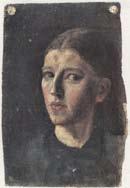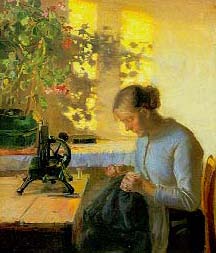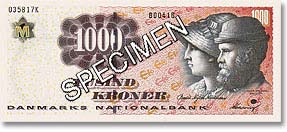
Danish artist Anna Kirstine Brøndum-Ancher was born in Skagen in 1859, the daughter of a grocer/hotel owner. Skagen was a Danish fishing community located on the northernmost tip of Jutland. It was also the site of a well-regarded artist colony, where Danish marine painters had received their inspiration throughout the nineteenth century. Thus, the many local artists in the area influenced Anna Ancher at an early age, and her talents soon became evident, so much so that she received the opportunity to be educated in the arts. Since the Royal Danish Academy of Fine Arts did not accept women at the time, she studied first at the Vilhelm Kyhm College of Painting in Copenhagen and later in Paris under Puvis de Chavannes.
Meanwhile, the Skagen artist community had taken an important turn in the early 1870s, when painter and poet Holger Drachmann visited, and soon-to-be museum director Karl Madsen, who initiated what would soon develop into one of Scandinavia’s most important summer art colonies. It was during this time that artist Michael Ancher first visited Skagen; Anna would come to marry him in 1880 and together they would have one daughter.
 The Anchers became part of the Impressionist group known as the Skagen Painters, with Anna being the only woman in the group. Other prominent painters included Norwegian artists Frits Thaulow and Christian Krohg, and Swedish painter Oscar Björck. Other artists, collectors, and writers visited the colony during this time as well. However, Anna Ancher was also the only one of the Skagen Painters who was actually born and raised in Skagen.
The Anchers became part of the Impressionist group known as the Skagen Painters, with Anna being the only woman in the group. Other prominent painters included Norwegian artists Frits Thaulow and Christian Krohg, and Swedish painter Oscar Björck. Other artists, collectors, and writers visited the colony during this time as well. However, Anna Ancher was also the only one of the Skagen Painters who was actually born and raised in Skagen.
Although the Skagen Painters differed in terms of style, they pioneered the important late-nineteenth-century art movements of Danish naturalism and Neo-Romanticism. Like the French Impressionists in Paris, they also pursued plein-air painting, or painting outdoors at the site of the subject rather than in a studio, and the wondrous effects of color and light they captured in this way characterized their paintings. Like many of their contemporaries, they also sought to portray the everyday lives of the local population, a new type of realism that was just emerging in the late 1800s.
Anna Ancher’s work centered firmly in this Skagen movement. Drawn to the work of Vermeer, and influenced by Whistler, and other contemporaneous artists, she developed her own style as a character painter, depicting interiors, and simple intimate themes from the everyday lives of women and children, as well as other locals. She was true to her era in her dedication to realism, to depicting the truth of how the people around her went about their everyday lives. However, what makes her art so distinct was her observations of the way different colors intersect with natural light. Her use of light and shadow, and the complexities of color lend a genuineness to her paintings that reverberates to this day.
 Anna Ancher, received the Tagea Brandt Rejselegat award in 1924, an annual prize created and endowed by a Danish industrialist in honor of his wife that recognized distinguished Danish female academics, artists, and writers. Throughout the history of women, she stands alongside other female pioneers of the late nineteenth century like Mary Cassatt, who were expected to fulfill the traditional duties of females of the time, such as marriage, motherhood, and running a household. However, despite being discouraged from pursuing a career, they women managed to pursue a career and make a name for themselves in a world where men were still dominant. Her paintings not only add to the canon of Danish impressionist painting, but also give us a glimpse of the female sensibilities of the time in the way she pursued her art, and portrayed her subjects.
Anna Ancher, received the Tagea Brandt Rejselegat award in 1924, an annual prize created and endowed by a Danish industrialist in honor of his wife that recognized distinguished Danish female academics, artists, and writers. Throughout the history of women, she stands alongside other female pioneers of the late nineteenth century like Mary Cassatt, who were expected to fulfill the traditional duties of females of the time, such as marriage, motherhood, and running a household. However, despite being discouraged from pursuing a career, they women managed to pursue a career and make a name for themselves in a world where men were still dominant. Her paintings not only add to the canon of Danish impressionist painting, but also give us a glimpse of the female sensibilities of the time in the way she pursued her art, and portrayed her subjects.
In 1967, the house of Michael and Anna Ancher opened as a museum, and visitor attraction, where their paintings and many other works created by the Skagen Painters, are still available for viewing today.
Sources:
artnet.com: Resource Libary: Anna Archer
The Grove dictionary of art: From renaissance to impressionism : Styles and Movements in Western Art, 1400-1900. by Jane Turner
